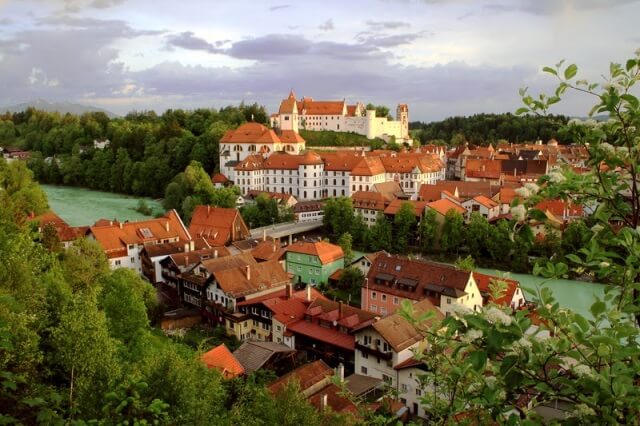Füssen, the Allgäu’s romantic soul
We have indulged – at least in our fantasies – in tasty ‘Weisswursts’, scrumptious cheese, rustic dumplings and divine desserts. Now it’s time to leave the dinner table or beer garden stall and start exploring some of the Bavarian Alps’ spectacular mise-en-scènes. Today we will discover the Anziehungskraft of some of Germany’s most noteworthy castles and palaces.
Let’s begin just a few kilometres outside the town of Füssen at Schloss Neuschwanstein, known as “the mother of all German castles”. It was built from 1869 to 1886 for King Ludwig II. Ironically, the “fairytale king” commissioned its build so that he could have a place to retreat away from the public eye; but today the castle, that inspired many of Walt Disney’s creations, attracts approximately 6,000 daily visitors during the summer months. Neuschwanstein Castle emulates many inspirations, including the Romanesque style, murals representative of Wagner’s famous operas and conceptions from theatrical set designers, artisans and conventional architects.
From Neuschwanstein Castle, you can see another royal palace: Schloss Hohenschwangau. This castle was rebuilt by King Maximilian II, King Ludwig II’s father, in 1832. (The original dates back at least to the 12th century). A young King Ludwig spent his childhood summers at Hohenschwangau Castle. Although not as conspicuous as Neuschwanstein, the castle offers an enticing guided tour. Highlights include the “Hall of Heroes”, a large banquet hall ornamented by paintings reflecting this theme; and the kings’ dressing room that houses a piano believed to have been played by Richard Wagner when he visited the royal family.
If you head east to Bavaria’s largest lake, Lake Chiemsee, you will arrive at the island of Herreninsel. In 1873, King Ludwig II obtained the island which was already home to what was formerly the Herrenchiemsee Benedictine Abbey founded in the eighth century; later it became known as the Old Palace. King Ludwig II lived in the Old Palace to supervise the construction of the New Palace, the Royal Palace of Herrenchiemsee. The plans for the palace were modelled after the French Versailles. Although the entire design was not completed, today the site still showcases King Ludwig’s visions for splendour, including the Great Hall of Mirrors, the courtyard’s lavish fountains and his private, French rococo-style apartment.
Other Bavarian Alps’ royal attractions worth mentioning include Linderhof Palace and the King’s House on the Schachen Alp. But this German region has even more to offer than imperial architecture. Stay tuned for our future blogs on monasteries, scenic drives, events, hiking and more.

